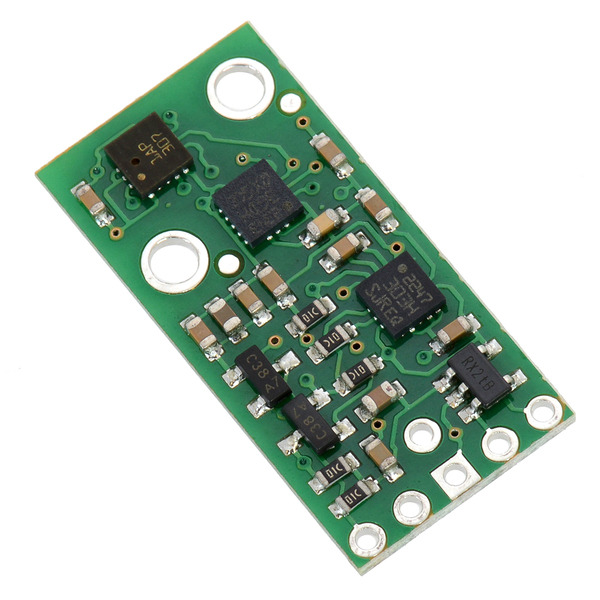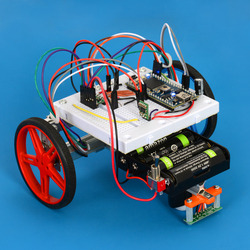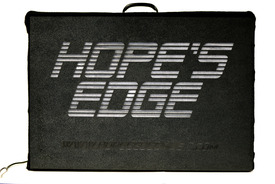Pololu Blog »
Pololu Blog (Page 66)
Welcome to the Pololu Blog, where we provide updates about what we and our customers are doing and thinking about. This blog used to be Pololu president Jan Malášek’s Engage Your Brain blog; you can view just those posts here.
Popular tags: community projects new products raspberry pi arduino more…
LVBots March 2014 dead reckoning competition
On March 6, LVBots held another competition at Pololu. This time, it was a dead reckoning contest: each robot had to find a line course and follow it to its end while keeping track of its position, then try to return to its starting position without any external navigational aids. Scoring was based on how close to the starting position the robot ended up, as well as how quickly it got there. The complete rules are available here (23k pdf). You can see a selection of the entries in this video compilation from the contest.
David has already posted about his entry. My robot was R2-DR, the miniature astromech droid, and I’ll be writing a post about it soon, too.
Are you in the Las Vegas area? Check out the LVBots Meetup page and drop by this Thursday, March 20, to see the robots in person!
Updates: You can read more about each of our robots in these blog posts:
- David and Fang’s dead reckoning robot based on the mbed LPC1768
- Brandon’s dead reckoning robot
- R2-DR, Kevin’s dead reckoning robot
- Claire’s dead reckoning robot
- Paul’s dead reckoning robot
- Jon’s dead reckoning robot
- Jamee’s dead reckoning robot
Maestro-controlled Pan, Tilt, and Zoom (PTZ) dome camera
Pololu forum member Dev255 modified a PTZ dome camera system to be controlled by an old Xbox joystick using a 24-channel Maestro servo controller. The Maestro reads 5 potentiometers on the Xbox joystick, along with some buttons, and correlates the readings to a speed and direction value. This data is converted to the Pelco D protocol that is used by the camera and gets sent to the camera from the Maestro. The LEDs on the joystick are used to indicate the program status. He also uses the Maestro to control a 4×20 character LCD display shown in the video below.
For more information on this project, see Dev255’s original forum post.
New products: MinIMU-9 and AltIMU-10 v3
We are happy to introduce new v3 versions of our MinIMU-9 and AltIMU-10 inertial measurement units (IMUs). These sensor modules are the same compact sizes as their predecessors and have same pin-out, but they are based on ST’s newer and better L3GD20H 3-axis gyro and LSM303D 3-axis accelerometer/magnetometer. The nine independent rotation, acceleration, and magnetic measurements from these sensors provide all of the information required make an attitude and heading reference system (AHRS). In addition to this, the AltIMU-10 v3 incorporates an LPS331AP digital barometer that can be used to measure pressure and altitude.
 |
The new revisions offer a wider magnetic sensing range and a more accurate and stable gyro, all with lower power consumption, and they include an extra pin for changing the I²C slave addresses so that two boards can be used on the same I²C bus. They should generally be usable as drop-in replacements for our previous MinIMU-9 v2 and AltIMU-10 modules—which we have put on clearance—though changes to register locations might require updates to software that is not based on our Arduino libraries.
We also have individual carrier boards available for the L3GD20H gyro, LSM303D accelerometer/magnetometer, and LPS331AP barometer if your application doesn’t require quite so much data or if you want to build your own AHRS unit.
ToDo and Babel by Chris Eckert
Chris Eckert makes devices that explore the artistic potential of factory automation. One of his works, entitled ToDo, is an automated wall mounted device that seems to continuously write a never-ending list of things to do. Two stepper motors control the position of a pen over a roll a paper, and a servo controls the pen’s up/down movement. The device is controlled by an Arduino Uno and two of our A4988 stepper motor drivers. You can find more details about the construction in Chris’s blog posts about Todo and see more of Todo on its gallery page.
Chris is currently working on another project called Babel, which will feature about 20 devices similar to ToDo.
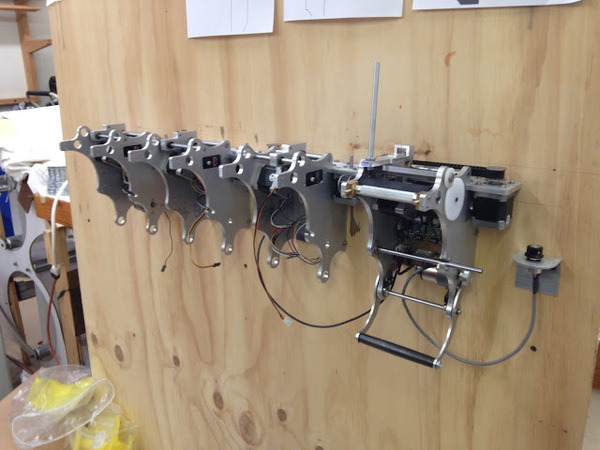 |
You can learn more about Chris and his artwork on his personal website.
David and Fang's dead reckoning robot based on the mbed LPC1768
Several people here at Pololu made robots to compete in the LVBots dead reckoning competition last week. This post is about the robot I made along with another engineer here.
Dead reckoning is the process of continuously calculating your position using internal sensors that tell you something about what speed and direction you are going. In our dead reckoning competitions, robots demonstrate that they are capable of dead reckoning by following a long, twisting line drawn on the floor and then driving back to their starting point. The line functions as a user interface that directs the robots through a sequence of moves for which it was not preprogrammed. The robots are scored based on the time they took and how close they were to the starting point at the end. Continued…
New distributors around the world
We are excited to welcome several new distributors that have joined Pololu over the past few months!
 |
To start with, we have gained two new distributors in the United States. We have been following Adafruit Industries (New York, NY) for a long time – I remember receiving a SpokePOV kit as a birthday present back in 2007 – so we are particularly excited that they will now be selling some of our products. They are starting with the Zumo, which they featured in a recent new product video. We will also be distributing some of their products, such as the Adafruit Data Logging Shield for Arduino. Is there anything from Adafruit that you would like to see at Pololu? Please let us know in the comment section.
 |
Anibit Technology (Cary, NC) is another new US distributor, founded in 2013 by engineer Jon Wolfe, who is marketing his own designs along with parts from Pololu and Adafruit. We are looking forward to seeing what else he will create!
 |
Next, MiniRobot (Azcapotzalco, Mexico City, Mexico), joins a number of other Mexican distributors. They carry a large selection of parts, including many Pololu items, as well as Arduinos, components, and prototyping supplies.
 |
Continuing south, we have a new distributor in Viña del Mar, Chile: Zambeca. In addition to carrying a number of Arduino, Lilypad, and robotics-related products, they have been posting some interesting-looking project videos on their blog (in Spanish). We have one other distributor in Chile, MCI Ltd – Olimex Chile, who has been with us since 2009.
 |
We now have a distributor in China, ALSRobotBase, located in Harbin, Heilongjiang province. They have a whole “Pololu” category and are also offering to help customers in China with special orders.
 |
Finally, Pimoroni in Sheffield, United Kingdom, is a new distributor specializing in accessories for the Raspberry Pi. They join a number of other UK distributors.
For distributors in your area, you can check out our complete list of almost 200 distributors.
Free Elektor magazine March 2014
 |
Get a FREE copy of Elektor magazine’s March issue with your order while supplies last. To get your free issue, enter the coupon code ELEKTOR0314 into your shopping cart. The magazine will add 6 ounces to the package weight when calculating your shipping options.
For other issues and more information, see our Free Elektor Magazine Offers page. All issues are now available for shipping worldwide!
Dead reckoning and wall following with a Zumo
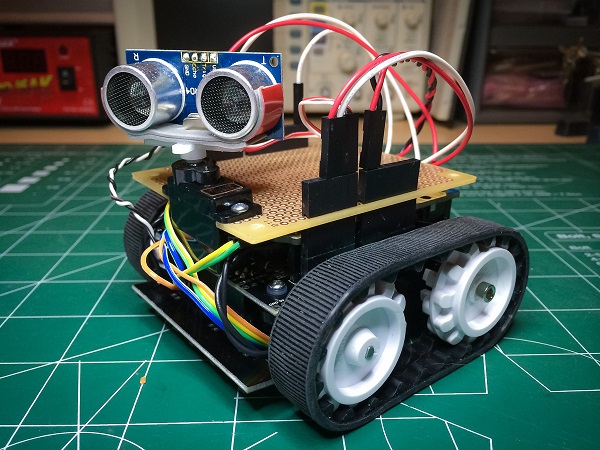 |
Forum user solderspot recently posted on our forum about some modifications he’s been making to his Zumo robot. First, he added our optical encoders for micro metal gearmotors to his robot, which required using motors with extended back shafts and cutting holes in the chassis to route the wires from the encoders.
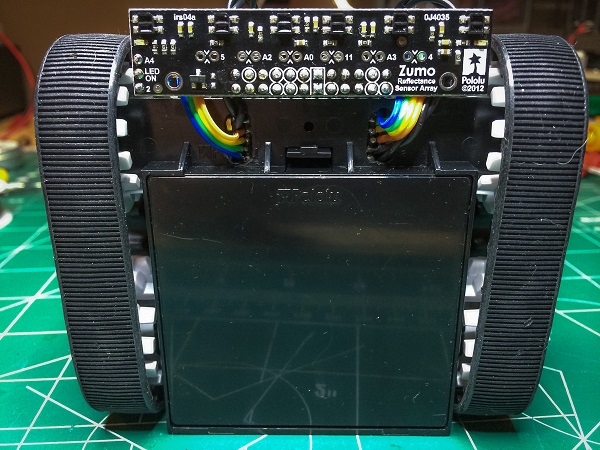 |
This allows his Zumo to navigate by dead reckoning, using just the information from the encoders.
He also mounted a sonar sensor on a servo to his robot, which enables it to find its way around a room by following the walls.
A series of articles on solderspot’s blog, starting with this one, covers his experience building and programming his robot. It looks like solderspot has further plans for the Zumo, including more sophisticated autonomous navigation, so watch his blog if you want to keep up with the latest developments.
New product: L3GD20H 3-Axis Gyro Carrier
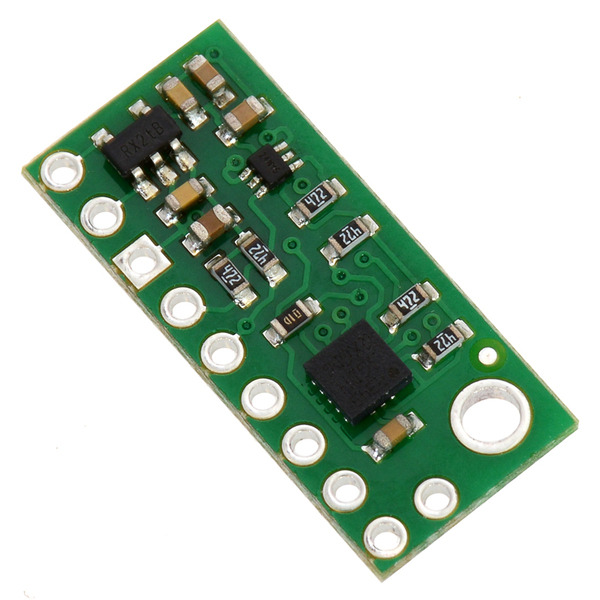 |
We have new gyros fresh out of the oven. No, I’m not talking about a Greek dish. I’m talking about our new L3GD20H 3-axis gyro carrier.
One of the most important measures of a rate gyroscope’s performance is the amount of noise in its output, which is indicated by its noise density specification. Too much noise means that the gyro will be prone to spurious indications of rotation, and if the gyro readings are integrated to track orientation, noise will cause the calculation to drift over time.
Although sensor fusion can help compensate for this drift by combining the gyro data with an absolute reference (like magnetometer data), using a lower-noise gyro is likely to be a more effective way to improve orientation tracking accuracy. In that respect, one of the biggest improvements of the L3GD20H over its predecessor is that it has a 60% lower rate noise density (0.011 dps/√Hz compared to 0.03 dps/√Hz on the L3GD20).
In addition to accuracy and stability improvements, the L3GD20H offers other advantages. Its power consumption is lower and its start-up time is much shorter. A wider range of user-selectable output data rates is available, including lower frequencies that are appropriate for human gesture detection, and a data enable (DEN) pin allows readings to be synchronized with external triggers. The L3GD20H makes all of these features available in a smaller package than previous gyros, which has allowed us to design a correspondingly smaller carrier board for it while still keeping it breadboard-friendly. For more information, see the L3GD20H carrier product page.
If you don’t need the latest and greatest, the L3GD20 is still a nice sensor, and it’s a good time to grab one now that we’ve lowered the price of our L3GD20 carrier to only $14.95 until stock runs out.
Hope's Edge LED Banner
 |
Local indie artist and Pololu employee Tracey, intent on reviving her programming skills and exploring her budding interest in electronics, shed some light on her creative personality by making an LED banner for her band, Hope’s Edge. The banner is a briefcase-sized container that uses an addressable LED strip to shine through a stencil of the band’s logo in a wave of brilliantly changing colors. The stencil and the rest of the panels in the container are made from 1/16" black ABS, all of which were cut with our custom laser cutting service, and a sheet of gift-wrap tissue paper is taped to the inside of the front panel to act as a diffuser. The banner runs off of a 5V wall wart, which is boosted to 9V to power an Arduino Uno that runs Ben’s Christmas light LED code.
|
|

